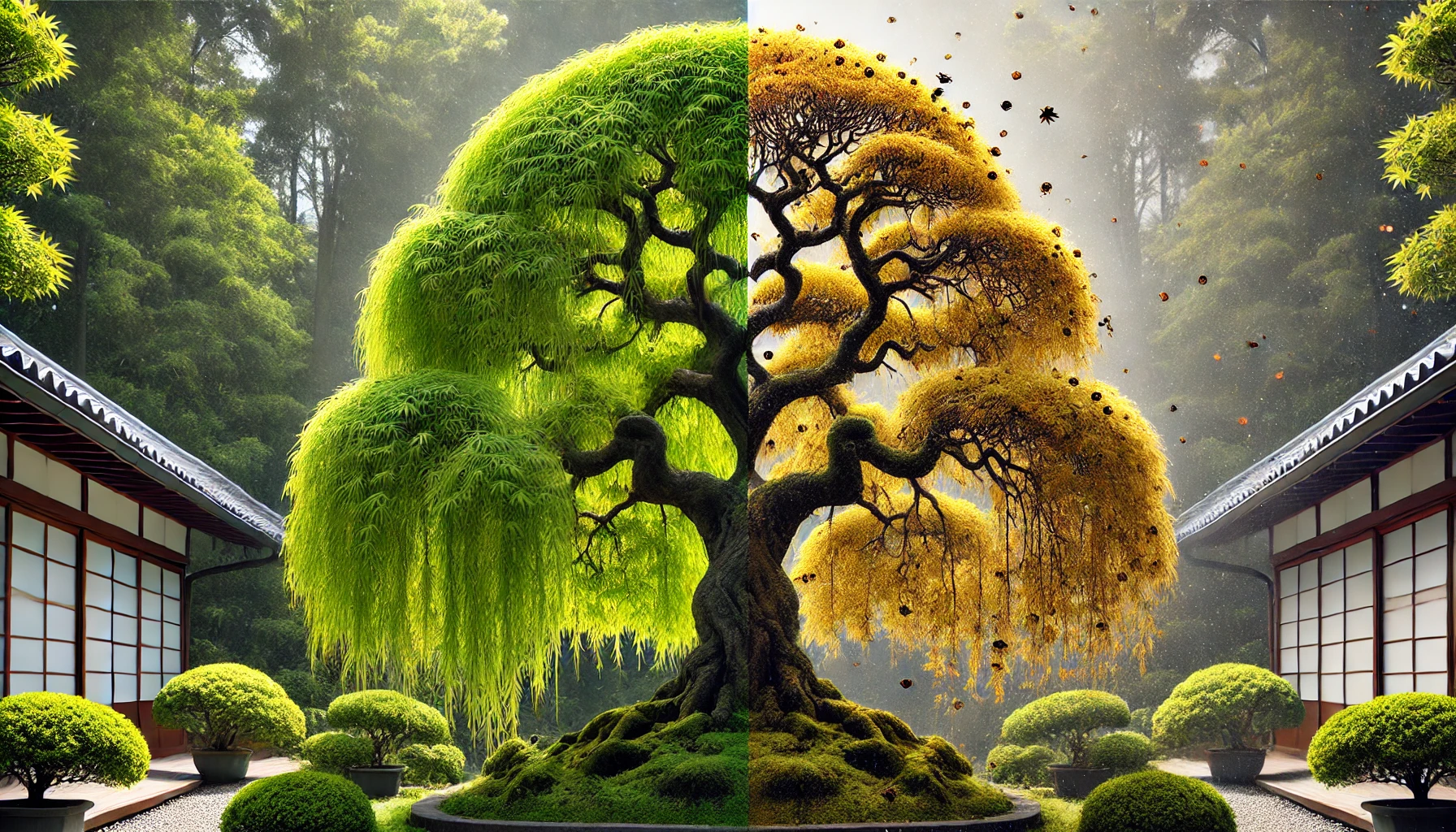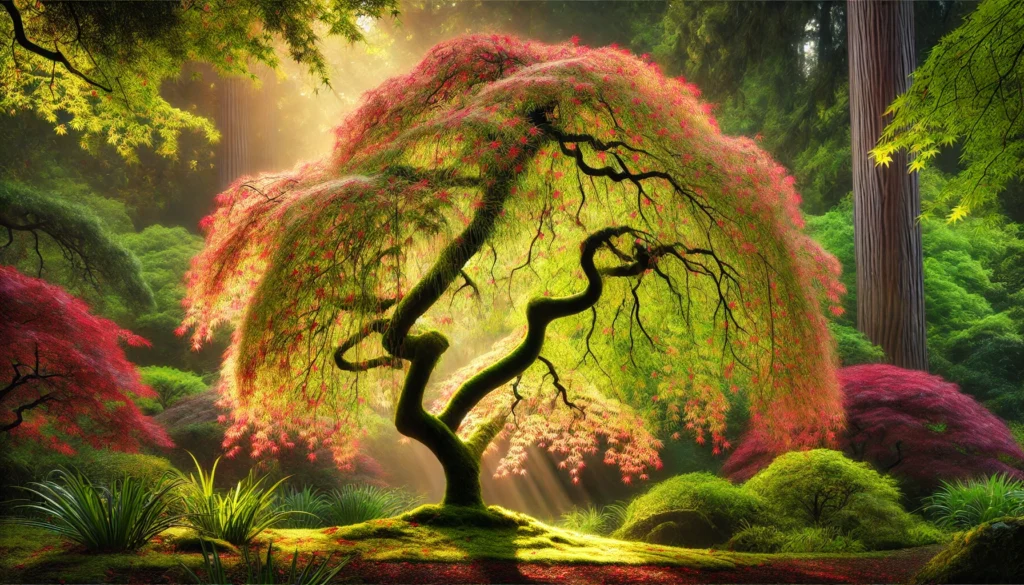
How to Care for Japanese Weeping Maple Trees: Expert Tips for Thriving, Beautiful Trees
Japanese Weeping Maple Trees are a stunning addition to any garden, known for their graceful, cascading branches and vibrant seasonal colors. 
If you’ve noticed your tree’s branches drooping or its leaves not as vibrant as they should be, you’re not alone. Many gardeners face challenges in keeping their Japanese Weeping Maple healthy, but with the right knowledge, these issues can be easily addressed. In this guide, we’ll provide you with expert tips on watering, pruning, and protecting your tree from pests, so you can enjoy a thriving, beautiful Japanese Weeping Maple for years to come. Keep reading to discover how simple adjustments can unlock the full potential of your tree’s beauty!
Table of Contents
ToggleWhy Choose Japanese Weeping Maple Trees?
Japanese Weeping Maple trees (Acer palmatum ‘Dissectum’) are a stunning addition to any garden, offering both beauty and versatility. Here are some compelling reasons why you should consider adding one to your landscape:

1. Stunning Aesthetic Appeal 
The most obvious reason to choose a Japanese Weeping Maple is its striking appearance. With its delicate, cascading branches and vibrant foliage, this tree adds elegance and charm to any space. Whether it’s the rich red of fall leaves or the soft green in spring, the tree creates a dramatic focal point that draws attention year-round.
2. Compact and Space-Saving 
Japanese Weeping Maples are perfect for smaller yards or garden spaces. Unlike traditional large trees, their compact size makes them ideal for urban landscapes, patios, or even in containers. You can enjoy a gorgeous tree without worrying about it taking up too much room!
3. Low Maintenance 
While Japanese Weeping Maples do need some care, they are relatively low-maintenance compared to other trees. They thrive in partial shade and don’t require constant pruning or complex fertilization routines. If you’re a beginner gardener, this is a tree that’s easy to love and care for.
4. Seasonal Interest 

One of the standout features of this tree is its ability to provide beauty throughout all four seasons. Spring brings fresh, tender leaves; summer offers lush green foliage; autumn delivers fiery red and orange hues; and winter reveals the elegant structure of the weeping branches. You get a unique experience with every season!
5. Perfect for Adding Texture and Contrast 
The fine, lacy leaves of a Japanese Weeping Maple make it a great tree to add texture and contrast to your garden. It pairs beautifully with larger, more structured plants and shrubs, helping to create a balanced and dynamic landscape design.
6. Drought-Resistant 
Japanese Weeping Maples are relatively drought-tolerant once established, making them a great choice for areas with dry spells or gardens that are prone to being under-watered. Just make sure to water them deeply during the first few years of growth!
7. Attracts Wildlife 
This tree also supports local wildlife, including pollinators like bees and butterflies, thanks to its flowers in the spring. While it doesn’t produce fruit, it still plays a role in your garden’s ecosystem, making it a natural choice for environmentally-conscious gardeners.
In short, Japanese Weeping Maple trees are a stunning, low-maintenance, and adaptable choice for anyone looking to elevate their garden with a touch of elegance. Whether you have a small space or a large garden, this tree will bring beauty and charm to your landscape!
Understanding the Growing Needs of Japanese Weeping Maple Trees 
Japanese Weeping Maple trees (Acer palmatum ‘Dissectum’) are known for their graceful appearance and vibrant foliage. But to ensure these stunning trees thrive, it’s essential to understand their unique growing needs. Here’s a breakdown of what your Weeping Maple requires to flourish:
1. Perfect Location for Growth 
Japanese Weeping Maples need a spot that mimics their native environment in Japan. They thrive in partial shade, where they receive some sunlight but are protected from harsh midday sun. Too much direct sunlight can scorch their delicate leaves, while too little can slow their growth. Aim for a location with dappled sunlight or morning sun and afternoon shade.
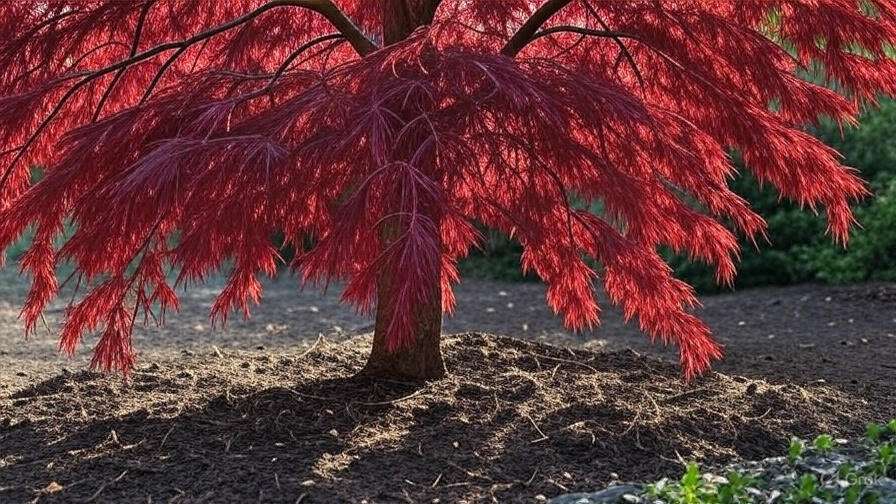
2. Well-Drained Soil 
These trees don’t like “wet feet”! Ensure your soil is well-drained but moist. Sandy loam or a mix of organic matter and soil will do wonders. If the soil stays too soggy, it could lead to root rot, which is detrimental to the health of your tree. If you live in a wetter climate, consider planting your tree on a slight mound to improve drainage.
3. Regular Watering 
While Japanese Weeping Maples are relatively drought-tolerant once established, they need regular watering in their first few years to develop strong roots. During dry spells, water deeply and consistently. However, make sure the tree isn’t sitting in standing water. A good rule of thumb: water the tree when the top 1-2 inches of soil feel dry to the touch.
4. Fertilizing for Healthy Growth 
Japanese Weeping Maples are not heavy feeders, but they do benefit from a light feeding in spring and summer. Use a balanced fertilizer, preferably one slow-release or organic, to encourage steady growth. Avoid over-fertilizing, as too much nitrogen can lead to weak growth and fewer leaves. A light touch is all they need!
5. Proper Pruning 
Pruning is key to maintaining the tree’s shape and health. Regularly remove dead, damaged, or crossing branches to allow the tree to focus its energy on healthy growth. The best time to prune is late winter or early spring before new growth begins. Remember, Japanese Weeping Maples have a delicate structure, so avoid excessive pruning—less is more!
6. Protection from Strong Winds 
Due to their cascading branches, Japanese Weeping Maples are prone to wind damage. If you live in a windy area, plant your tree in a sheltered location, or consider using windbreaks to protect it. This will keep the tree’s delicate branches from snapping during storms.
7. Mulching for Temperature Control and Moisture Retention 
Apply a layer of mulch around the base of your Japanese Weeping Maple to help retain moisture, control temperature fluctuations, and prevent weed growth. Be sure not to pile mulch against the trunk, as this can encourage rot. Aim for a 2-3 inch layer, spread evenly around the root zone.
By understanding and meeting these growing needs, you’ll ensure that your Japanese Weeping Maple thrives for years to come. With the right care, it will reward you with stunning foliage and a beautiful, cascading silhouette in your landscape.
How to Plant a Japanese Weeping Maple Tree 
Planting a Japanese Weeping Maple tree (Acer japonicum) can transform your garden into a serene, picturesque space. Known for its graceful cascading branches and vibrant foliage, this tree thrives with a little care and attention. Here’s a step-by-step guide to help you plant and enjoy your very own Japanese Weeping Maple:
1. Choose the Right Location 
Japanese Weeping Maples love partial shade or dappled sunlight, making them ideal for areas with morning sun and afternoon shade. Ensure your planting site has:
- Well-draining soil: These trees do not like soggy feet!
- Plenty of space: While they grow slow, they can spread out as they mature, so give them enough room to grow both up and out.
2. Prepare the Soil 
Before planting, it’s important to prepare the soil:
- Loosen the soil in a 3-foot radius around the planting area to help the roots establish.
- Mix in organic matter like compost to improve drainage and nutrients.
- Check the pH level: Japanese Weeping Maples prefer slightly acidic soil (pH 5.5 to 6.5).
3. Dig the Planting Hole 
Dig a hole that’s about twice the size of the root ball of your tree. The hole should be deep enough that the top of the root ball sits level with the ground. If it’s too deep, the roots might suffocate; if it’s too shallow, the tree will not settle in well.
4. Plant the Tree 
- Remove the tree from the pot gently, and if the roots are circling, loosen them with your fingers or a small rake.
- Place the tree in the center of the hole. Make sure it’s straight and positioned properly.
- Fill the hole with the amended soil, pressing lightly to remove air pockets. Water generously after planting to settle the soil around the roots.

5. Mulch Around the Base 
Add a 2-3 inch layer of mulch around the base of the tree to:
- Retain moisture
- Keep the roots cool
- Prevent weeds from competing for nutrients
Be careful not to pile the mulch directly against the trunk, as this can cause rot.
6. Water Regularly 
Keep the soil consistently moist but not soggy, especially during the first year of growth. Water deeply once a week (more often if it’s particularly hot or dry). Ensure proper drainage to avoid waterlogging the roots.
7. Monitor and Care for Your Tree 
- Fertilizing: After the first year, you can fertilize your tree with a balanced, slow-release fertilizer in early spring.
- Pruning: Prune any dead or damaged branches in early spring to keep the shape of your tree neat. Be sure to remove any branches that grow inward or cross each other.
By following these simple steps, your Japanese Weeping Maple will thrive, adding beauty and tranquility to your garden for years to come. Happy planting!
Essential Care for Japanese Weeping Maple Trees
Caring for your Japanese Weeping Maple (Acer palmatum ‘Dissectum’) is key to ensuring it thrives, offering stunning beauty year-round. With the right care, these trees can add elegance and charm to any garden. Here’s how to keep your Japanese Weeping Maple happy and healthy.
1. Choose the Right Location 
Japanese Weeping Maples love partial shade, so pick a spot that gets a few hours of direct sunlight in the morning or late afternoon. Avoid harsh, midday sun, which can scorch their delicate leaves. Ensure the spot has well-drained soil to prevent root rot, a common issue for these trees.
2. Watering Needs 
While these trees are relatively drought-tolerant once established, they still need consistent watering during their first few years. Water deeply once a week during dry periods, ensuring the soil stays moist but not soggy. Mulching around the base helps retain moisture and keeps the roots cool in hot weather.
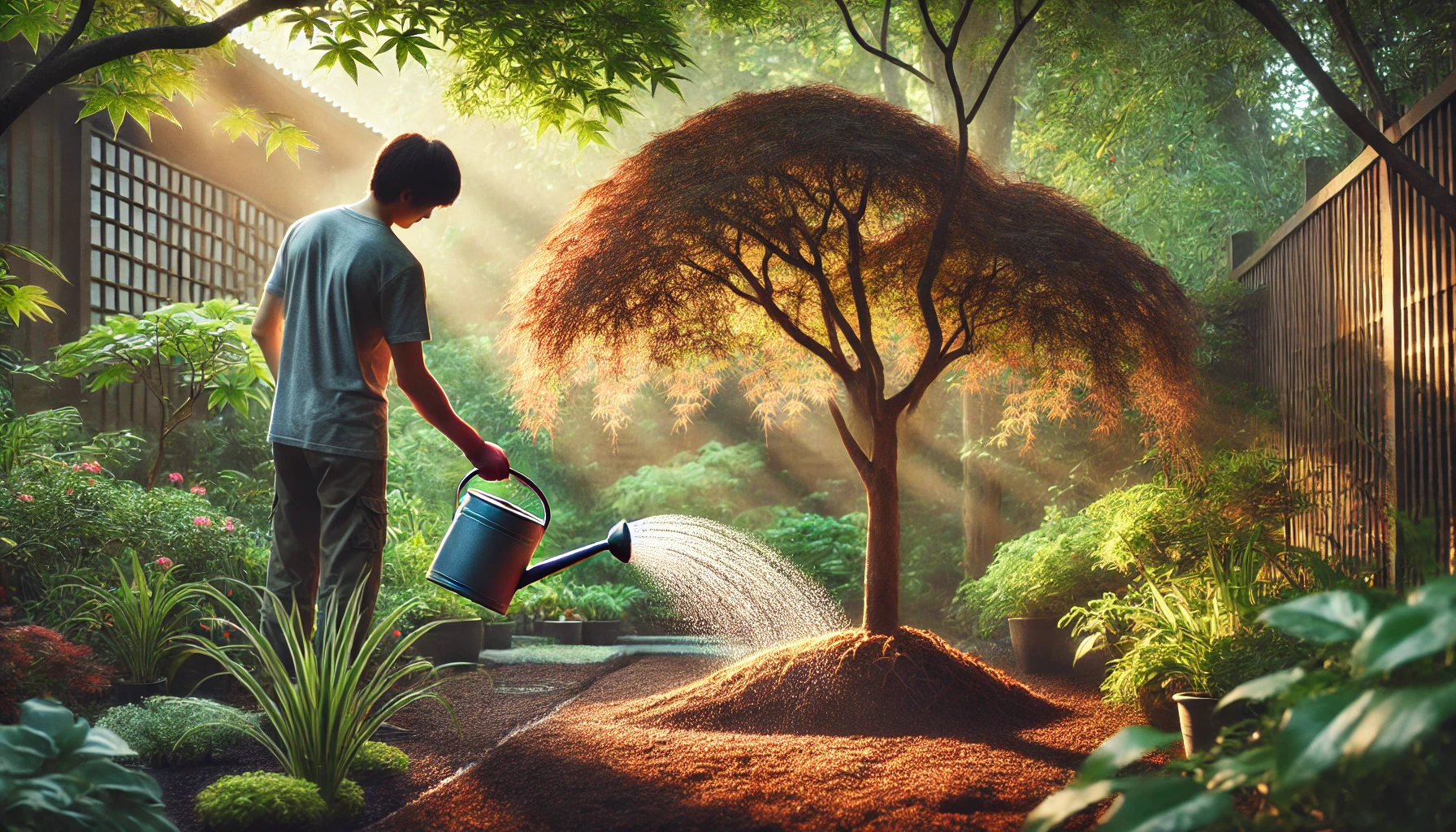
3. Soil and Fertilizing 
Japanese Weeping Maples prefer slightly acidic, loamy soil. If your soil is too heavy or clay-like, consider amending it with compost or well-rotted organic matter. Fertilize your tree in early spring with a balanced, slow-release fertilizer to support healthy growth. Avoid over-fertilizing, as this can lead to weak, leggy growth.
4. Pruning for Health and Shape 
Pruning is essential for maintaining the graceful shape of your Weeping Maple. Remove dead or damaged branches in early spring before new growth begins. Light pruning can also help control the size and prevent overcrowding. Avoid heavy pruning, as this can stress the tree and compromise its beauty.
5. Protection from Pests and Diseases 
Although Japanese Weeping Maples are relatively pest-resistant, they can still fall victim to aphids, spider mites, and fungal infections. Keep an eye on your tree, especially during the growing season. If you notice any signs of pests or disease, treat them promptly with insecticidal soap or a fungicide designed for maples.
6. Winter Care 
While hardy, these trees benefit from some winter protection. Mulch around the base to insulate the roots during cold spells. If you’re in an area with heavy snow, gently brush off snow from the branches to prevent breakage, as the weight of snow can cause damage to the delicate weeping branches.
7. Repotting for Container Grown Trees 
If you’re growing your Japanese Weeping Maple in a container, make sure to repot it every 2-3 years to refresh the soil and provide more space for the roots. Choose a slightly larger pot and ensure it has proper drainage to avoid waterlogging.
By following these essential care tips, your Japanese Weeping Maple will thrive, enhancing your landscape with its vibrant colors and elegant form. Whether you’re growing it in a garden or a container, these steps will help you keep your tree in top shape, season after season.
Common Problems and Solutions for Japanese Weeping Maple Trees 
Japanese Weeping Maples are beautiful and elegant, but like all trees, they can face a few challenges. Here’s a quick guide to help you troubleshoot common problems and find easy solutions to keep your tree healthy and thriving.
1. Leaf Discoloration (Yellow or Brown Leaves) 
- Problem: If the leaves turn yellow or brown, it could be a sign of several issues, like overwatering, underwatering, or nutrient deficiency.
- Solution:
- Overwatering: Ensure the soil is well-draining. Japanese Weeping Maples prefer slightly moist soil but can’t tolerate soggy roots.
- Underwatering: If the soil feels dry, give your tree a deep watering.
- Nutrient Deficiency: Consider fertilizing with a balanced, slow-release fertilizer in early spring.
2. Leaf Curling or Wilting 
- Problem: Curling or wilting leaves can indicate stress from pests, disease, or extreme weather.
- Solution:
- Pests: Check for signs of aphids or scale insects. If you spot pests, gently rinse the leaves with water or use insecticidal soap.
- Weather Stress: Protect your tree from harsh winds and direct, scorching sunlight, especially during hot summers. You can use shade cloth or plant near other trees for shelter.
3. Tree Not Growing or Failing to Thrive 
- Problem: If your Japanese Weeping Maple seems stunted or isn’t growing, it could be a soil issue, poor placement, or lack of proper care.
- Solution:
- Soil: Make sure your tree is planted in well-draining, slightly acidic soil. Amend the soil if necessary.
- Placement: Ensure your tree gets enough light but is shielded from intense midday sun.
- Proper Care: Regularly prune dead or diseased branches to allow for new growth. Apply mulch to retain moisture and regulate temperature.
4. Pests and Diseases 

- Problem: Pests like aphids, scale insects, and spider mites can harm the tree. Fungal diseases can also affect the health of your Weeping Maple.
- Solution:
- Pest Control: Apply insecticidal soap or neem oil to control pests naturally. Regularly check the undersides of leaves for early signs of infestation.
- Disease Prevention: Keep the tree’s canopy open to improve air circulation, and avoid overhead watering, which can encourage fungal growth.
5. Root Rot 
- Problem: If you notice wilting, yellowing leaves, or a foul smell around the base of the tree, root rot may be the cause.
- Solution:
- Prevention: Always plant your tree in well-draining soil and avoid overwatering. Raised beds or mounds can help improve drainage if you have clay-heavy soil.
- Treatment: If root rot is already present, carefully remove the affected roots and replant the tree in fresh, well-draining soil.
6. Improper Pruning 
- Problem: Incorrect pruning can harm the tree, affecting its growth and appearance.
- Solution:
- When to Prune: Prune your Japanese Weeping Maple in late winter or early spring before new growth starts.
- How to Prune: Remove dead, diseased, or crossing branches. Be sure to maintain the tree’s natural shape and avoid cutting too much at once.
7. Browning of New Growth 
- Problem: New growth turning brown may be caused by environmental stress, nutrient imbalance, or excessive fertilizer.
- Solution:
- Environmental Stress: Protect your tree from extreme temperatures and wind.
- Nutrient Imbalance: Avoid over-fertilizing. If you’re using a fertilizer, choose one with balanced nutrients and follow the manufacturer’s recommendations carefully.
8. Tree Leaning or Falling Over 

- Problem: If your Japanese Weeping Maple is leaning or toppling over, it’s often due to poor root development or an unstable planting site.
- Solution:
- Replanting: If the tree is too tilted, gently dig it up and replant it in a deeper, more stable hole.
- Staking: Use stakes to support the tree until it establishes stronger roots, but be careful not to tie the tree too tightly.
By addressing these common issues promptly and with care, you can keep your Japanese Weeping Maple tree healthy and beautiful for years to come!
Seasonal Care for Japanese Weeping Maple Trees 

Caring for your Japanese Weeping Maple (Acer palmatum ‘Pendulum’) throughout the year ensures it remains healthy, vibrant, and beautiful. Each season brings its own set of care tasks that are essential for your tree’s well-being. Here’s a quick guide to what you should do in each season:
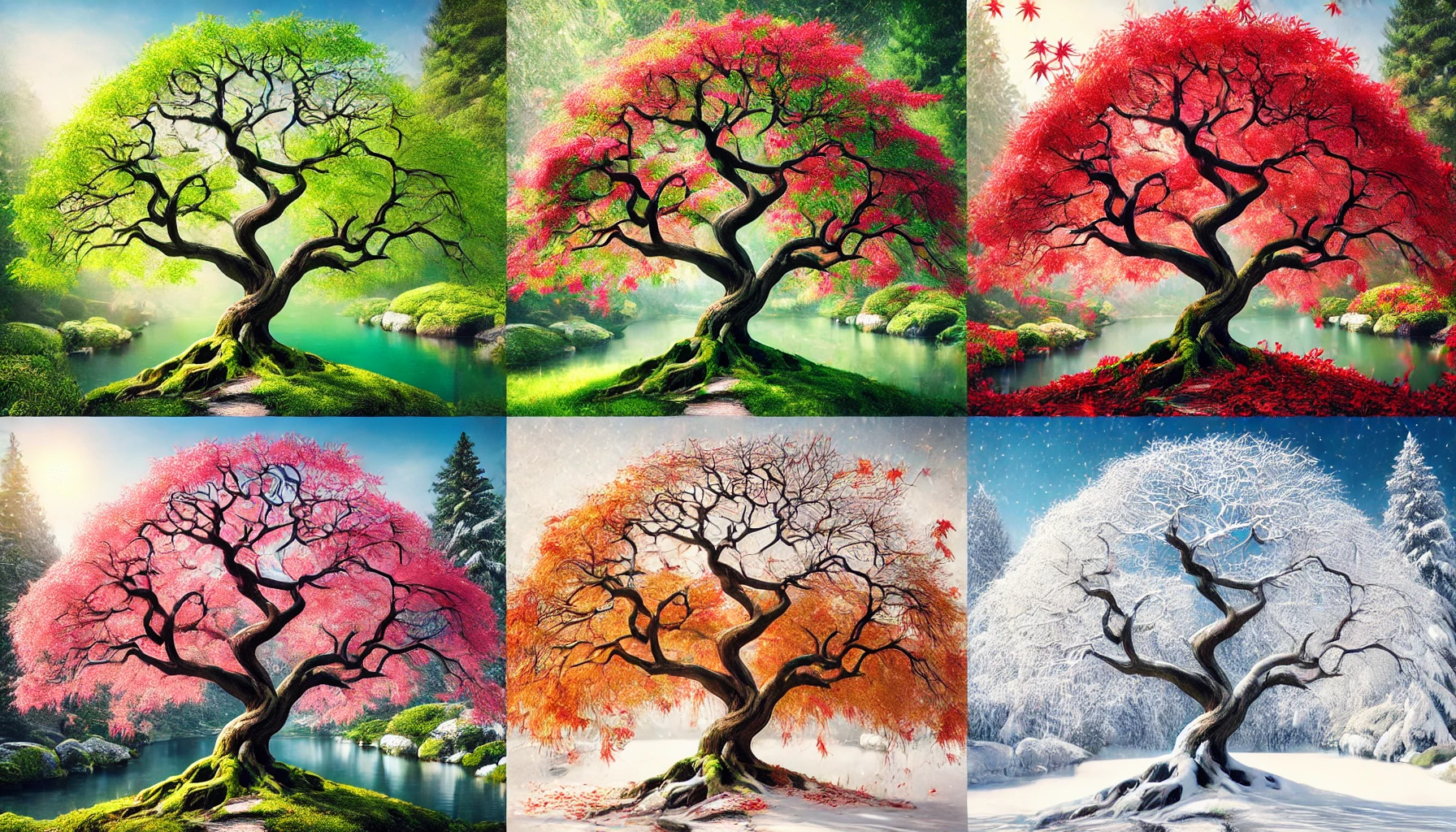
Spring: New Growth & Pruning 
As the temperatures warm up, your weeping maple will begin its spring growth. This is the perfect time to:
- Prune Dead or Damaged Branches: Remove any dead or broken branches to promote healthy new growth.
- Fertilize Lightly: Apply a balanced, slow-release fertilizer to encourage strong growth without overfeeding.
- Water Consistently: Ensure the soil remains moist but not soggy. Deep watering is essential as the tree establishes itself for the growing season.
Pro tip: Avoid heavy pruning in spring as it can stress the tree. Focus on shaping and removing any dead wood.
Summer: Protecting from Heat & Pests 

Summer heat can be tough on your Japanese Weeping Maple, so focus on maintaining its health by:
- Deep Watering: Water deeply once or twice a week, especially during hot spells, to keep the roots hydrated.
- Mulch to Retain Moisture: Apply a 2-3 inch layer of mulch around the base to help retain soil moisture and keep roots cool.
- Check for Pests: Look out for common pests like aphids or scale insects, and treat them promptly with an eco-friendly pesticide or neem oil.
Pro tip: Avoid overhead watering during summer to reduce the risk of fungal diseases.
Fall: Preparing for Winter 

As the weather cools, it’s time to prepare your weeping maple for the winter months:
- Reduce Watering: Gradually reduce watering as the tree enters dormancy. The tree doesn’t need as much moisture in the fall.
- Clean Up Fallen Leaves: Remove any fallen leaves and debris from around the base of the tree to prevent fungal growth.
- Fertilize Lightly (if needed): Apply a light dose of fertilizer to support root development for the following spring.
Pro tip: If your region experiences harsh winters, consider wrapping the tree’s trunk in burlap or tree guards to protect it from extreme cold and wind.
Winter: Minimal Care & Protection 

Winter requires the least intervention but is still important for the health of your Japanese Weeping Maple:
- Protect from Snow & Ice: Heavy snow can break branches, so gently brush off snow. Avoid letting ice accumulate on branches.
- Monitor for Cold Damage: Check the tree periodically for signs of damage from freezing temperatures, such as cracked bark or frozen roots.
Pro tip: If temperatures drop extremely low, using frost cloths or tree wraps can provide an extra layer of protection.
By following these seasonal care tips, your Japanese Weeping Maple will flourish and provide stunning beauty year-round. Whether it’s pruning in spring or protecting it from winter cold, your tree will thank you with lush foliage and graceful weeping branches.
Conclusion
Caring for Japanese Weeping Maple Trees is a rewarding experience that brings beauty and elegance to your garden throughout the year. By understanding their unique needs for sunlight, soil, watering, and pruning, you can ensure your tree thrives in every season. With the right care, your Japanese Weeping Maple will reward you with its graceful weeping branches and vibrant foliage, becoming a stunning focal point in your landscape.
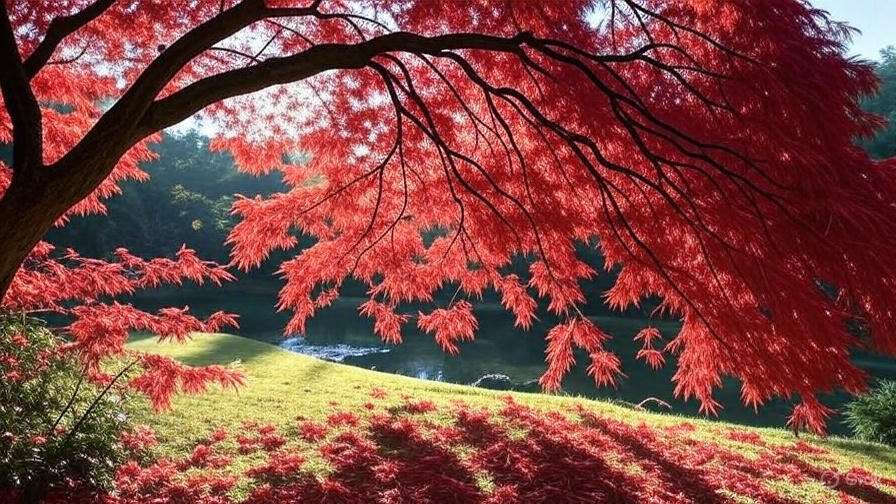
Remember, patience is key—these trees may take some time to fully establish, but the effort will be worth it when you see their breathtaking beauty unfold. Follow the expert tips shared in this guide, and you’ll be well on your way to enjoying a healthy, flourishing Japanese Weeping Maple for years to come.
Happy gardening, and here’s to creating a landscape filled with the timeless beauty of your Japanese Weeping Maple!
Frequently Asked Questions(FAQ)
How often should I water my Japanese Weeping Maple Tree?
Japanese Weeping Maple Trees prefer consistently moist soil, especially during the growing season. Water deeply once a week, ensuring the soil doesn’t dry out completely. In hot, dry weather, you may need to water more frequently, but avoid overwatering to prevent root rot.
When is the best time to prune a Japanese Weeping Maple?
The ideal time to prune your Japanese Weeping Maple is late winter or early spring, just before new growth begins. This helps the tree heal quickly and promotes healthy growth. Avoid pruning in late summer or fall, as this can damage the tree and disrupt its natural growth cycle
Why are the leaves on my Japanese Weeping Maple turning yellow?
Yellowing leaves can be a sign of overwatering, poor drainage, or a nutrient deficiency. Check the soil to ensure it’s not soggy, and consider adding a balanced fertilizer. If the tree is planted in heavy, clay-like soil, amend it with compost to improve drainage.
How do I protect my Japanese Weeping Maple from pests?
Common pests like aphids, scale insects, and Japanese beetles can damage your Japanese Weeping Maple. To prevent pest problems, regularly inspect your tree and treat it with insecticidal soap or neem oil if pests are found. Pruning damaged or infected branches also helps reduce pest risk.
Can I grow a Japanese Weeping Maple in a container?
Yes, Japanese Weeping Maples can thrive in containers if they have enough space for their roots. Choose a large container with good drainage and use well-draining, acidic soil. Remember to water regularly and repot every few years to prevent root crowding.
What soil is best for a Japanese Weeping Maple Tree?
Japanese Weeping Maples prefer well-drained, slightly acidic soil with a pH of 6.0–6.5. They thrive in loamy or sandy soil that doesn’t retain excessive moisture. To improve drainage, amend the soil with organic compost or peat moss if needed.
How do I prevent my Japanese Weeping Maple from getting too leggy?
To prevent legginess, ensure your tree receives enough sunlight—at least 4–6 hours of direct sunlight per day. Prune regularly to encourage a more compact shape and to remove any weak or elongated branches. Avoid excessive shading or overwatering, both of which can promote leggy growth.
How can I keep my Japanese Weeping Maple healthy during the winter?
In colder climates, provide winter protection by covering young trees with burlap or using windbreaks to prevent frost damage. Apply a layer of mulch around the base to insulate the roots. Continue to water the tree during dry spells in winter to prevent dehydration.


